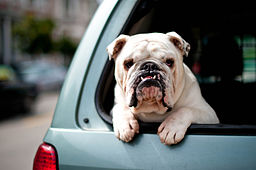
Several weeks ago, I was in a car accident. The car in the lane next to me lost control and came into my lane, pushing my car into the median at 70 mph. When my car finally came to a stop, and I realized I was okay, my first thought was thank God I didn’t have my dog with me.
Even though I was okay, I couldn’t shake the feeling that things could’ve been a lot worse. I always put my dog on a harness in the back of the vehicle, with room enough to stick his snout out of the window, but even that, I fear, would not have been enough to keep him safe under the circumstances. Even more scary, had he been with and not restrained by his seat belt, I can almost guarantee he wouldn’t be here today, and for no good reason at all.
Why Restrain Your Pet in A Vehicle?
The accident got me thinking about the seriousness of dog safety in the car, and how seemingly overlooked it is. The honest truth is, if you would buckle up a toddler (which of course you would, duh), why wouldn’t you take the same precautions with your dog? Big, small, or medium sized, it doesn’t matter; dogs need the same safeguards as people when it comes to riding in a vehicle.
To be honest, I’m surprised that dog restraints and car safety is not more closely regulated. It seems like a no-brainer that any sort of living thing in the car should be protected, but it’s true; dog safety in the car has largely been left up to the owner’s choice, with only those ‘crazy dog people’ being the ones who restrain their dogs while traveling.
In 2010, AAA teamed up with Kurgo, a maker of pet travel products, to conduct a survey on the topic. According to AAA’s Jennifer Huebner-Davidson, AAA National, Traffic Safety Programs Manager,
“An unrestrained 10-pound dog in a crash at only 30 mph will exert roughly 300 pounds of pressure, while an unrestrained 80-pound dog in a crash at only 30 mph will exert approximately 2,400 pounds of pressure. Imagine the devastation that can cause to your pet and anyone in its path.”
That’s a pretty scary fact. And yet, of the survey respondents, only 16% claimed to use some form of restraint for their traveling dogs.
Now, this is a dog blog, and I’m a dog lover, so I’ve been focusing on the importance of restraining your dog for sake of his safety. But let’s not forget: having an unrestrained animal – dog or cat – in the vehicle, is not only a safety hazard for the animal, but it can also pose a dangerous distraction to the driver.
Respondents of the AAA/Kurgo survey admitted to a whole host of distracting behaviors resulting from unrestrained pets. This ranged from petting dogs, trying to keep them out of the front seat, letting the dog ride in their lap (nearly ⅕ of respondents admitted to this one – yikes!), and even taking pictures of their dogs while driving. These results are not something I want to think about when I’m out on the road.
In a handful of states, things are starting to move in the right direction. In New Jersey, for example, drivers can be cited for an unrestrained dog or cat in the vehicle. A few other states are following suit, working on their own legislation for cutting down on distracted driving due to unrestrained animals. Hopefully it won’t be long until this is the norm, and drivers are educated on the threat their unrestrained animal poses to themselves, all those in the car, as well as others out on the road.
Let’s Talk About Options
It’s not necessarily people’s ignorance that leaves their dog’s safety to chance in the car, but just the fact that people don’t know they have any option for restraining their dog. You might be surprised to find, however, that there are plenty of options out there.
- Seatbelt Restraints
Seatbelt restraints are a great way to give your dog a little freedom while still keeping him contained. There are tons to choose from, so no matter what kind of dog/car combination you’re working with, you’re covered. Among them, Kurgo, Ruff Rider, and Clickit. All these companies (and many others) make a variety of sizes and styles, so you can be sure to get the one that’s right for your dog. - Barriers
Pet Barriers work by separating the front seat from the back seat. There are a number of types, from kennel-like walls, to soft panels that hook into place. While they won’t necessarily keep your dog contained in an accident, they’ll definitely help to keep him confined to the back of the vehicle. - Kennels
Some people insist on kenneling their dogs while driving. That said, we don’t all have room to keep a kennel in our cars. This is where seatbelt restraints and barriers can really be a value. Not to mention we don’t all have dogs that would tolerate being kenneled on a car ride.
No matter what kind of dog you have (or what kind of car you have), there are plenty of options out there to help keep both you and your pet safe when you hit the road. And I hope I’ve shown you that leaving your dog free to wander the vehicle shouldn’t be one of them. Restraining your dog will not only keep him from distracting you, but it will likely keep him much safer in the event of an accident. Who knows – maybe one day, it’ll be the law!
